On Fire!
Want your home to have a warm and cozy feel? There is no quicker way to achieve this feeling than with a fireplace! There are an indefinite number of selection combinations when designing the perfect fireplace. So, we wanted to share a few important tips and tricks to get you to the fireplace of your dreams.
The first important decision to be made is the type of fireplace to be selected. There are four main options: wood burning, gas, electric, and ventless.
Wood Burning
Wood burning fireplaces are the most classic option, however, this type of fireplace comes with maintenance after each use. Additionally, wood must be supplied, and the chimney will need to be cleaned thoroughly each year. The sounds and smells of the crackling fire may be worth it! It is also important to note that anything compostable must be at least 12 inches away from the firebox. This type of fireplace has a nostalgic appeal that other types of fireplaces do not have - making this a timeless element of your home.
Gas
The next type of fireplace is gas. Gas fireplaces are the most efficient type, with their high level of heat output. Another benefit of the gas fireplace is the ability to turn it on and off at the flip of a switch. Gas fireplaces come in a variety of styles, making this a great choice for any home. Again, it is important to note that anything compostable must be at least 12 inches away from the firebox.
Electric
Next, electric fireplaces are an appliance created to provide heat for your home using a heating element, along with a screen to visually display a flame. One unique feature of the electric fireplace is its ability to produce a visual flame while the heat is turned off. This allows you to have the visual element of the flame (the definition of “cozy vibes”) without the heat if your home gets too warm! Because of this, electric fireplaces are a great choice for homes with children and pets, as there is no risk of being burned. There are many different styles of electric fireplaces, so finding one to suit your design style is definitely possible!
Ventless
Lastly, ventless fireplaces are a great option, as they do not require a chimney or vent. They can be placed on any internal wall in your home! Ventless gas fireplaces are unique, as they burn gas so cleanly, they do not produce any toxic fumes. With ventless fireplaces, it is important to note that there must be 22 inches of clearance before placing a compostable material. It is also important to note that these fireplaces are not allowed in bedrooms and the room must fit specific square footage requirements.
After you select which fireplace type best suits your home, you can begin making design selections, our favorite part!
There are many different material options for your fireplace, but we recommend stone, brick, tile, shiplap/paneling, concrete, or stucco. Each of these options has its own unique look, so select the one that best matches your home's style. It is important to select materials that are heat resistant around the firebox, as well.
So, when do these selections need to be made for your new build?
It is important to have selections made before framing begins! Here is why: your builder will make sure they can support the fireplace if you select a real brick or stone. It is also imperative to know what size firebox you have selected, as well. If you want a larger firebox than typical, make sure your builder knows this before framing, too, especially for slab foundation homes. If you select a cut brick or faux stone, the weight isn’t as much of an issue, but it is still important to communicate this selection with your builder.
Your last important decision is in regards to your hearth and mantle.
Your hearth can either be raised or flush. Raising the hearth allows you to sit in front of the fireplace, whereas leaving the hearth flush to the floor provides a more minimal look. Both are excellent options! After the hearth style has been selected, you can begin to design the mantle. There are many options, but floating mantles are the most popular currently. A floating mantle requires a nailer board or bracket to be attached to the studs, then to be covered with your choice of material. This provides a strong, safe support for the mantle, allowing it to last for years to come.
We hope these tips and tricks will help you when selecting the elements of your perfect fireplace.
We would like to thank Apex Construction of Monroe, Georgia, for their insight on this blog!
Our team would love to help you design the fireplace of your dreams!





